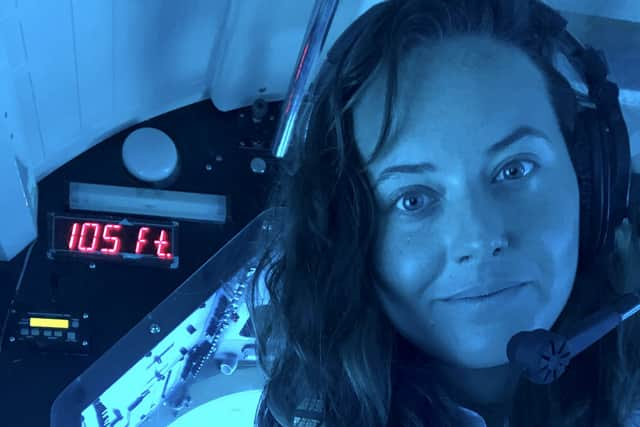Titanic sub: Ex-guide says underwater expeditions ‘safer than flying’ and urges tourists to keep enjoying them
and live on Freeview channel 276
A former submarine guide says underwater expeditions are “safer than flying” - and has urged tourists to keep enjoying them in the wake of the Titanic sub tragedy. Mckenzie Margarethe worked as a nature guide on board touring submarines for two years.
The 31-year-old and her team took tourists 110ft below the surface to marvel at the sea creatures and ship wrecks. Mckenzie and the crew submerged four to six times a day for 45 minute voyages off the coast of Hawaii where she grew up.
Advertisement
Hide AdAdvertisement
Hide AdThe marine scientist fears tourists might avoid submarine trips in the wake of the Titan tragedy. But she said people should keep enjoying the fascinating trips.
Mckenzie, now living in British Columbia, Canada, said: “My heart absolutely goes out to their families. But I also hope people don’t develop a fear of going on a touring submarine because of this tragedy.
“Touring submarines are very safe and it’s such a beautiful experience to see all the coral and the amazing creatures. It’s very different from the great depths the Titan was going to.
“Sure you’re aware of all that water on top of you, but when I fly I’m also aware of all that distance between me and the ground. There are so many safety features on the touring subs I worked on. It’s much safer than flying.
Advertisement
Hide AdAdvertisement
Hide Ad“If you can fly to Hawaii you can definitely go down in the submarines that I did. There’s a drop weight which stops a submarine rolling or bouncing. If anything goes wrong with coming back up you can release the drop weight so you’ll resurface.
“Even in a scenario where we lost all power there were vents on the sides that a diver could come and open - that allows compressed air to fill tanks which bring us up again.


“And everyone is so well trained. They know what to do in every possible situation and passengers’ safety is the number-one priority.”
Mckenzie, who has always been into coral conservation and marine invertebrates, was a free diver before her years on subs for Atlantis from 2017 to 2019. She accompanied vessels off the coast of Kailua-Kona on the island of Hawaii, taking 48 tourists with three crew.
Advertisement
Hide AdAdvertisement
Hide AdThere was always a surface ship with another three crew, and they were connected by a hydrophone, Mckenzie said. She added the pressure in the touring sub is constantly synchronised with surface air pressure so passengers don’t experience any difficulties when they come up.


Touring subs don’t go past 150 feet because that’s the lowest an experienced highly trained diver can reach. The wreck of the Titanic, which the vessel Titan was aiming to reach, is 12,500 ft down.
McKenzie’s most nerve-wracking moment was when a submarine was being tested, without tourists, at 178 feet, and she had to check for leaks. She said: “I never felt afraid, and I plan to go on submersibles in the future for my work.
“The Titan tragedy hasn’t changed that for me, but I would never go to that depth. I plan to go on subs that are certified for the depth they are going to.
Advertisement
Hide AdAdvertisement
Hide Ad“I trusted my crew completely. I was down there doing my job, and I was so unworried that I was never even aware of anything but the beautiful experience. My family knew I was safe. My dad came down and he loved it.
“The only thing that would give my family and friends comfort if that was the place where I had to go is that the sea is so beautiful and I love it.
“I hope in time their families and friends can have peace and know that they lost them to something these people really wanted to do and were willing to put their lives on the line to do but I expect it will be years before they can come to feel that. It’s heartbreaking and a terrible tragedy.”
Titan submersible implosion - what happened?
Titan, a submersible operated by American tourism company Oceangate, imploded durng its descent into the North Atlantic Ocean on June 18. The sub was carrying five people as part of an expedition to see the wreck of the Titanic, which sank in 1912.
Advertisement
Hide AdAdvertisement
Hide AdCommunication with the sub was lost 1 hour and 45 minutes into its dive to the wreck site. Authorities were alerted when the vessle failed to resurface at the scheduled time later that day.
After a search lasting nearly 80 hours, authorities discovered a debris field containing part of Titan about 500 metres from the bow of the Titanic. Evidence suggests the sub’s pressure hull had imploded while the Titan was descending, resulting in the instantaneous death of all five occupants inside.
Comment Guidelines
National World encourages reader discussion on our stories. User feedback, insights and back-and-forth exchanges add a rich layer of context to reporting. Please review our Community Guidelines before commenting.
